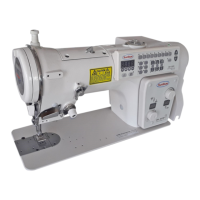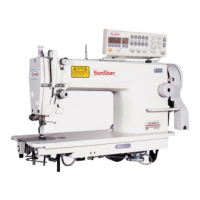15
[Figure 11]
5) Adjusting thread tension
The result of the needlework depends on the sewing conditions such as the sewing material, used thread and stitch length. So
please adjust as desired.
- good sewing
- upper thread tension is strong while the lower thread tension is weak.
- upper thread tension is weak while the lower thread tension is weak.
A. Adjusting the upper thread tension
As in Figure 12, turning the tension adjustment nut of the
thread adjusting device① clockwise makes the upper
thread tension stronger and counterclockwise makes it
weaker.
[Figure 12]
B. Adjusting the lower thread tension
As in Figure 13, turning the tension adjustment nut ① of the
hook clockwise makes the lower thread tension stronger and
counterclockwise makes it weaker.
C. Adjusting the thread take up spring tension
a) Adjusting the thread take up spring stroke
As in Figure 14, loosen the fastening screw①, and turn the stopper bushing of the thread take up spring ② clockwise to make
the stroke smaller and counter clockwise to make it bigger. The thread take up stroke is normally 5~10mm.
b) Adjusting the thread take up spring tension
As in Figure 15, insert the driver into the groove① of the thread tension control assembly. Turn clockwise to make the spring
tension stronger and counterclockwise to make it weaker. The thread take up spring tension is normally 50~80g.
[Figure 14] [Figure 15]
[Figure 13]
Weak
Strong
Strong
Strong
Weak
Weak

